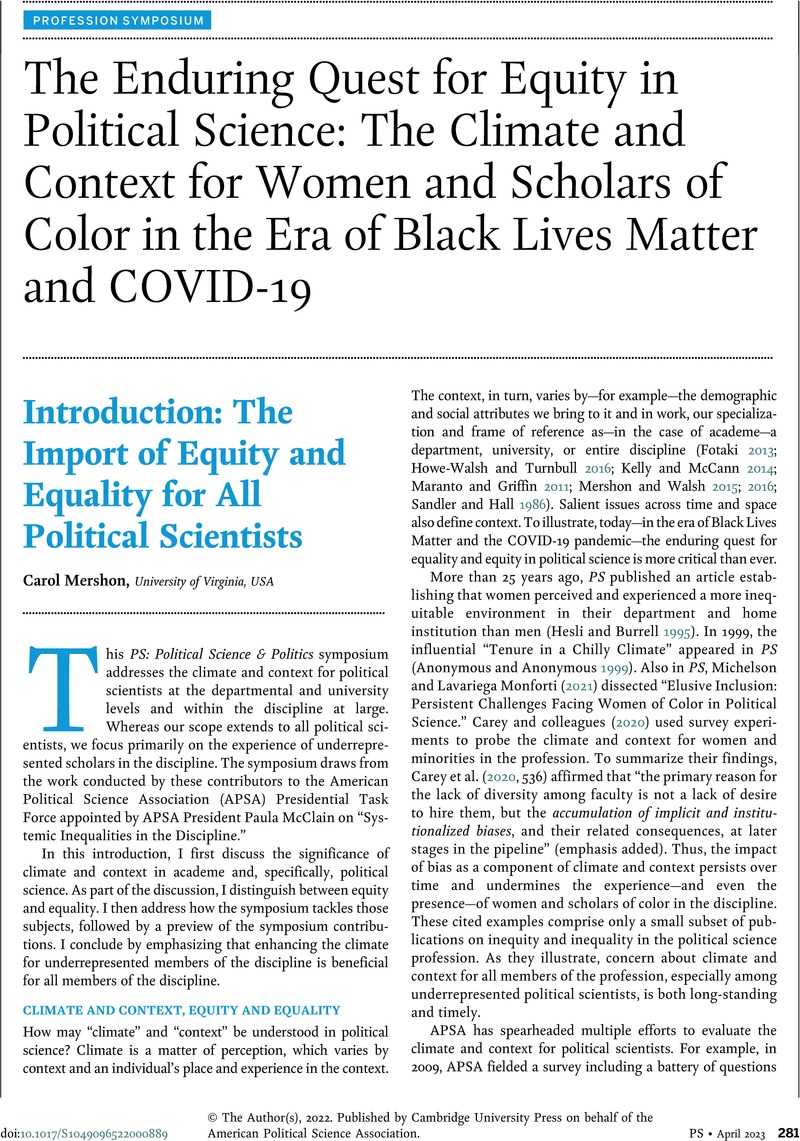No CrossRef data available.
Article contents
Introduction: The Import of Equity and Equality for All Political Scientists
Published online by Cambridge University Press: 25 November 2022
Abstract
An abstract is not available for this content so a preview has been provided. Please use the Get access link above for information on how to access this content.

- Type
- The Enduring Quest for Equity in Political Science: The Climate and Context for Women and Scholars of Color in the Era of Black Lives Matter and COVID-19
- Information
- Copyright
- © The Author(s), 2022. Published by Cambridge University Press on behalf of the American Political Science Association
References
REFERENCES
Ackerly, Brooke, Bednar, Jenna, Blofield, Merike, Chwe, Michael, Contreras, Carlos, Davis, Jason, Ewig, Christina, Sin, Gisela, Singer, David, Soifer, Hillel, Solomon, Johanna, and Williams, Nora Webb. 2018. “Leadership in Academic Climate and Excellence.” APSA Annual Hackathon. Washington, DC: American Political Science Association.Google Scholar
Ackerly, Brooke, and Franklin, Sekou. 2022. “Climate and APSA.” PS: Political Science & Politics. DOI: 10.1017/S1049096522001160.Google Scholar
Anonymous and Anonymous. 1999. “Tenure in a Chilly Climate.” PS: Political Science & Politics 32 (1): 91–99.Google Scholar
Carey, John M., Carman, Kevin R., Clayton, Katherine P., Horiuchi, Yusaku, Htun, Mala, and Ortiz, Brittany. 2020. “Who Wants to Hire a More Diverse Faculty? A Conjoint Analysis of Faculty and Student Preferences for Gender and Racial/Ethnic Diversity.” Politics, Groups, and Identities 8 (3): 535–53.CrossRefGoogle Scholar
Claypool, Vicki Hesli, and Mershon, Carol. 2016. “Does Diversity Matter? Evidence from a Survey of Political Science Faculty.” Politics, Groups, and Identities 4 (3): 483–98.CrossRefGoogle Scholar
Fotaki, Marianna. 2013. “No Woman Is Like a Man (in Academia): The Masculine Symbolic Order and the Unwanted Female Body.” Organization Studies 34 (9): 1251–75.CrossRefGoogle Scholar
Ghosh, Cyril, and Wang, Hongying. 2022. “Microaggression, Bullying, and Implicit Bias.” PS: Political Science & Politics. DOI: 10.1017/S1049096522001159.CrossRefGoogle Scholar
Hesli, Vicki, and Burrell, Barbara. 1995. “Faculty Rank among Political Scientists and Reports on the Academic Environment: The Differential Impact of Gender on Observed Patterns.” PS: Political Science & Politics 28 (1): 101–11.Google Scholar
Hong, Lu, and Page, Scott E.. 2004. “Groups of Diverse Problem Solvers Can Outperform Groups of High-Ability Problem Solvers.” Proceedings of the National Academy of Sciences 101 (46): 16385–89.CrossRefGoogle ScholarPubMed
Howe-Walsh, Liza, and Turnbull, Sarah. 2016. “Barriers to Women Leaders in Academia: Tales from Science and Technology.” Studies in Higher Education 41 (3): 415–28.CrossRefGoogle Scholar
Kelly, Bridget Turner, and McCann, Kristin I.. 2014. “Women Faculty of Color: Stories Behind the Statistics.” The Urban Review 46 (4): 681–702.CrossRefGoogle Scholar
Maranto, Cheryl L., and Griffin, Andrea E. C.. 2011. “The Antecedents of a ‘Chilly Climate for Women Faculty in Higher Education.’” Human Relations 64 (2): 139–59.CrossRefGoogle Scholar
Mershon, Carol. 2022. “Conclusion: Recent Steps and the Road Ahead in the Enduring Quest for Equity in Political Science.” PS: Political Science & Politics. DOI: 10.1017/S1049096522000890.CrossRefGoogle Scholar
Mershon, Carol, and Walsh, Denise. 2015. “How Political Science Can Be More Diverse.” PS: Political Science & Politics 48 (3): 459–63.Google Scholar
Mershon, Carol, and Walsh, Denise. 2016. “Diversity in Political Science: Why It Matters and How to Get It.” Politics, Groups, and Identities 4 (3): 462–6.CrossRefGoogle Scholar
Michelson, Melissa R., and Lavariega Monforti, Jessica L.. 2021. “Elusive Inclusion: Persistent Challenges Facing Women of Color in Political Science.” PS: Political Science & Politics 54 (1): 152–57.Google Scholar
Michelson, Melissa R., and Wilkinson, Betina Cutaia. 2022. “Best Practices in Diversifying Political Science.” PS: Political Science & Politics. DOI: 10.1017/S1049096522000804.CrossRefGoogle Scholar
Page, Scott E. 2007. The Difference: How the Power of Diversity Creates Better Groups, Firms, Schools, and Societies. Princeton, NJ: Princeton University Press.Google Scholar
#PSSistahScholar. 2022. PSSistahScholar, June 4. https://twitter.com/hashtag/PSSistahScholar?src=hashtag_click.Google Scholar
Sandler, Bernice R., and Hall, Roberta M.. 1986. “The Campus Climate Revisited: Chilly for Women Faculty, Administrators, and Graduate Students.” Project on the Status and Education of Women. Washington, DC: Association of American Colleges.Google Scholar
Sapiro, Virginia, and Campbell, David. 2018. “Report on the 2017 APSA Survey on Sexual Harassment at Annual Meetings.” PS: Political Science & Politics 51 (1): 197–206.Google Scholar
Simien, Evelyn, and Wallace, Sophia Jordán. 2022. “Exclusion and Disproportionate Service: Considering the Impacts for Women Academics and Faculty of Color in Political Science.” PS: Political Science & Politics. DOI: 10.1017/S104909652200110X.Google Scholar
Smooth, Wendy. 2016. “Intersectionality and Women’s Advancement in the Discipline and Across the Academy.” Politics, Groups, and Identities 4 (3): 513–28.CrossRefGoogle Scholar




